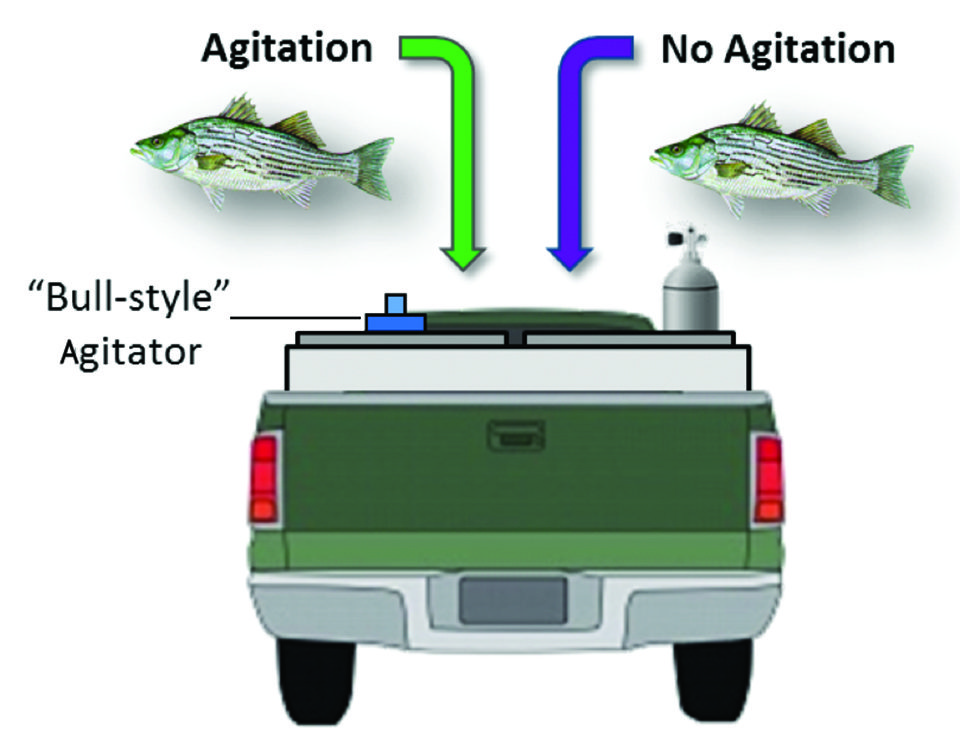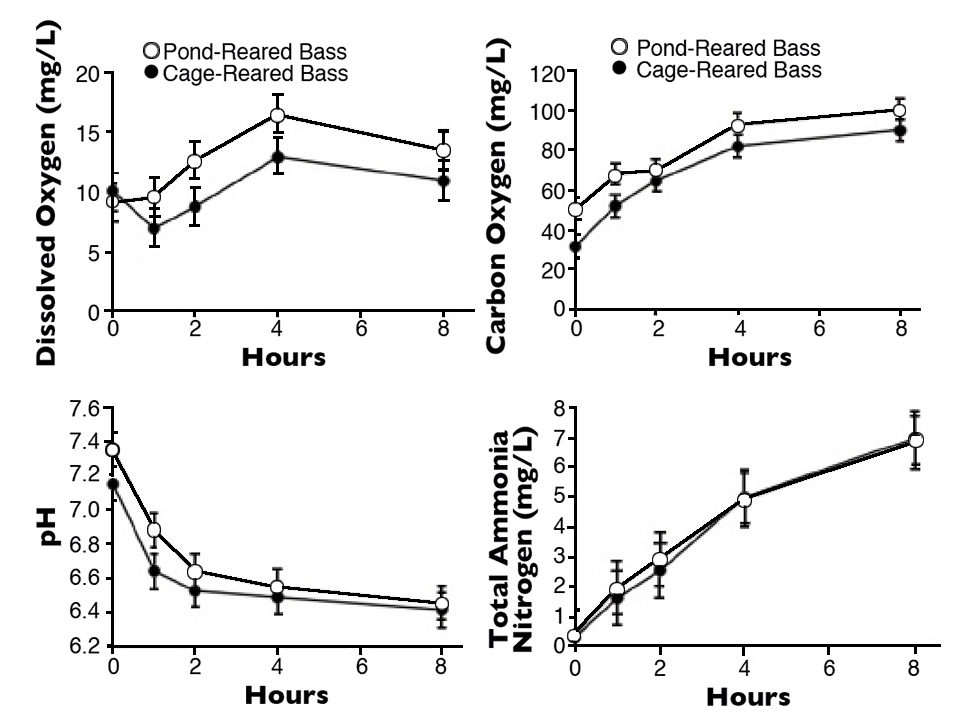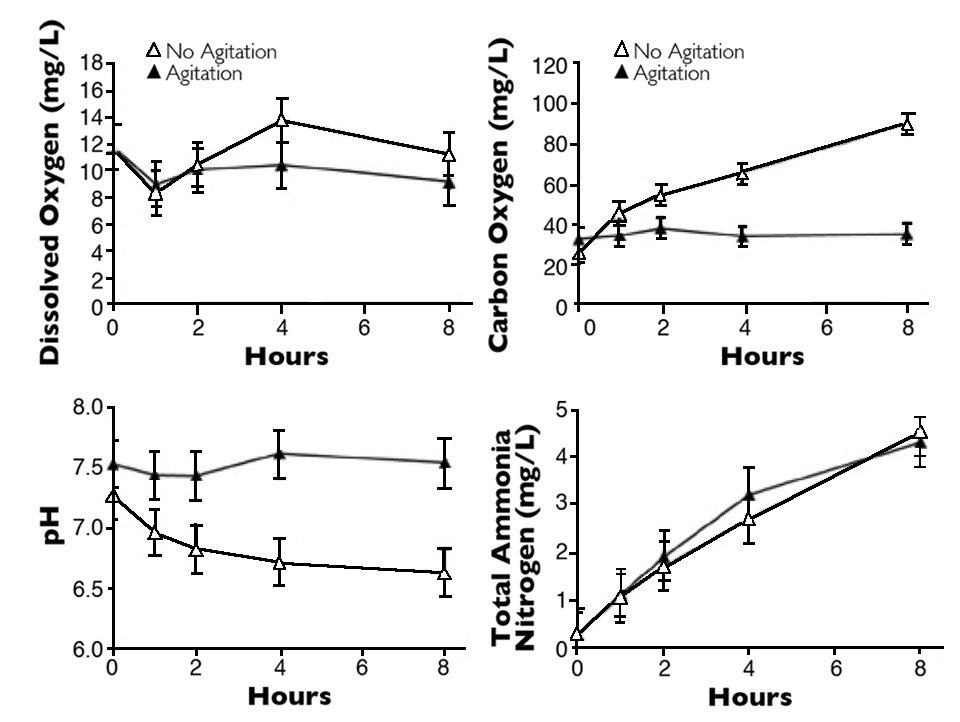Seining may contribute to poorer condition of pond-reared fish

A majority of the U.S. production of hybrid striped bass – a cross of female white bass, Morone chrysops, with male striped bass, M. saxatilis – is associated with farms located in the states of Texas, North Carolina and Florida. According to the U.S. Department of Agriculture, these farms were responsible for nearly 75 percent of the 5,634 mt of market-size fish produced in 2013. Although Illinois is a relatively minor contributor to domestic production, hybrid striped bass are the second most cultured fish in the state and represent a significant portion of its aquaculture industry.
Hybrid striped bass have been raised in a variety of culture systems in Illinois, including earthen ponds and floating cages. Most Illinois growers market their fish live, but these lucrative markets are typically in major metropolitan areas such as Chicago and New York City, which are located hundreds of kilometers from the majority of farms in southern Illinois. Transport times often range from six to 24 hours, so long and stressful live hauls are common. The results can include mortality, morbidity and fish in generally poor condition upon arrival.
Anecdotal information from Illinois growers has suggested that pond-reared hybrid striped bass are more vulnerable to transportation-related morbidity and mortality than cage-reared fish. To verify these reports and explore ameliorative strategies, the authors conducted two experiments to simulate live hauling of market-size hybrid striped bass.
Live transport of pond-, cage-reared fish
In one experiment, market-size fish with individual weights of 650 ± 13 g were harvested by seining from earthen ponds and dip netting from floating cages, then stocked at a rate equivalent to 97 g fish/L in a two-compartment, insulated aluminum live hauler and held for eight hours to simulate transport. About 60 pond-raised and 65 cage-raised bass were stocked. The procedure was repeated on four replicate days.
Water chemistry was measured and blood samples were taken from three fish at zero, one, two, four and eight hours (Figure 1). Since blood samples from one trial were improperly stored, the blood chemistry results reflected only three of the four replicate trials.
Changes in plasma cortisol, glucose, lactate and osmolality indicated all fish underwent an acute stress response following harvest and transport, but subtle differences in performance and conditions experienced by the pond- versus cage-reared fish suggested greater accumulation of carbon dioxide during transport of pond-reared fish may be problematic (Fig. 1).

Agitators manage water quality
In a second experiment with three replicate days, market-size fish with individual weights of 812 ± 12 g were seine harvested from earthen ponds and stocked in the same live hauler used in the first experiment. The bass were again held for eight hours of simulated transport. For this experiment, however, the live hauler was fitted with “bull-style” agitators powered by a 12-volt battery to provide continuous agitation during the simulated transport.
Although agitation mitigated the carbon dioxide accumulation and stabilized pH, the total ammonia nitrogen equilibrium shifted in favor of un-ionized ammonia nitrogen (Fig. 2). Minor differences in blood chemistry were noted, but the use of agitators did not substantially attenuate the stress response observed.

Transport limitations
The authors’ work suggested the anecdotal reports of pond-reared hybrid striped bass performing poorly during and after live transport were accurate. However, blood chemistry analyses failed to reveal significant differences between pond- and cage-reared fish. The only mortalities observed during the experiments were among the pond-reared fish, suggesting some distinction between these two “populations” of fish.
Increasing carbon dioxide and decreasing pH levels were identified as potential causal factors. The experiment with agitation to mitigate the carbon dioxide accumulation was successful in terms of these two aspects of water quality, but presented another challenge in terms of nitrogenous waste management. Such interactions among water quality parameters can complicate attempts to mitigate water quality-related stressors and achieve ideal transport conditions.
Perspectives
Experimental results suggested harvest-related handling can be a greater stressor than others experienced during transport, and seining may contribute to poorer condition of pond-reared fish during and after transport.
The authors recommend further research to identify strategies – allowing fish to recover between primary harvest and transport or the use of water treatments to neutralize ammonia, for example – to reduce stress and improve live transport of hybrid striped bass, particularly those raised in ponds.
Editor’s Note: This article was derived from a paper by the authors to be published in the forthcoming issue of the North American Journal of Aquaculture.
(Editor’s Note: This article was originally published in the July/August 2015 print edition of the Global Aquaculture Advocate.)
Authors
-
Kelli Barry
Center for Fisheries, Aquaculture and Aquatic Sciences
Southern Illinois University Carbondale
1125 Lincoln Drive, Room 251
Carbondale, Illinois 62901 USA -
John Bowzer, Ph.D.
Center for Fisheries, Aquaculture and Aquatic Sciences
Southern Illinois University Carbondale
1125 Lincoln Drive, Room 251
Carbondale, Illinois 62901 USA -
Jesse T. Trushenski, Ph.D.
Center for Fisheries, Aquaculture and Aquatic Sciences
Southern Illinois University Carbondale
1125 Lincoln Drive, Room 251
Carbondale, Illinois 62901 USA
Related Posts

Health & Welfare
Novel air-based system transfers large salmon during harvest
To evaluate the application of an air pressure-based transport method within a recirculating aquaculture system, the authors performed testing with harvest-size salmon at The Conservation Fund Freshwater Institute.

Aquafeeds
Novel light bank reactor aids in microalgae culture
The control of temperature and light intensity in microalgae culture in outdoor tanks is difficult. Progress in algal biotechnology and the use of photo-bioreactors, metabolic engineering and other advances supported development of a novel underwater light bank reactor that allows for more effective light utilization by cultured microalgae.

Innovation & Investment
Getting proficient in RAS fundamentals
A number of large salmon farming companies are now investing significantly to increase land-based, water recirculating aquaculture systems (RAS) in northern Europe and North America, and there is likely a need for more trained farm personnel to run and manage these and other close-containment aquaculture facilities.

Responsibility
For the future, a feed that makes fish feces float?
German researcher believes that floating fish feces – stemming from cork used in feed blends – would help recirculating aquaculture systems more efficiently remove suspended solids. The big question is, will feed manufacturers get on board?


